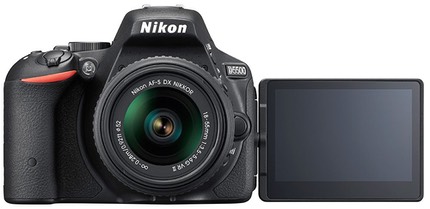
Thom's quick takes:
- Still relatively low price with high image quality
- Solid video capability
- Mostly plastic
- Must use AF-S lenses!
- Swivel and touchscreen LCD is handy and nice
- Built-in WiFi a plus for those that use it, though missing GPS a step backwards
Specifications:
- Introduced: 1/6/2015
- Expected Replacement: Replaced by D5600 in November 2016
- Current Firmware: C1.02 L2.016 (May 2017)
- Sensor Size: 23.5x15.6mm, DX ~1.53x crop
- Sensor Pixels: 24.2mp
- Sensor Manufacturer: Sony (Toshiba) IMX193AQK
- Sensor Technology: CMOS, Bayer, no AA filter, microlens
- Max Image Size: 6000x4000
- Other Image Sizes: 4496x3000, 2992x2000
- Video: 1080P 60/50/30/25/24, 720P 60/50/30/25, and VGA 30/25 (stored in .MOV with H.264 compression); stereo sound from built-in mic, or accessory jack
- ADC Bit Depth: 14 bit
- Raw File Formats: 12 bit and 14 bit Compressed NEF
- Other File Formats: JPEG
- JPEG/TIFF Rendering: 16-bit rendering, 8-bit output
- Auto Rotation: Yes
- Color Spaces: sRGB, Adobe RGB
- Storage: SD, SDHC, or SDXC, UHS-I and Eye-Fi
- Max Write Speed: ?MB/sec
- Max Buffer Size: ? JPEG Fine (100 @ any other JPEG setting), ? RAW (? with JPEG)
- Connectivity: USB 2.0 HIGH, Optional WiFi
- TV Support: NTSC and PAL, HDMI
- Lens Support: AF-S only (other AF don't focus)
- Autofocus Module: CAM4800DX (39 sensor, 9 crosshatch)
- Shutter Lag: ?ms
- Autofocus Modes: Single, Dynamic, Auto Area, 3D Tracking
- AF Assist: Yes (white lamp)
- Metering: 2016-pixel Color matrix, centerweight, spot
- Exposure Modes: PSAM + 8 Scene
- Exposure Compensation: +/- 5 stops, 1/3 stop or 1/2 stop
- Exposure Bracketing: Yes, 3 frames (plus ADL, WB bracketing), 2-frame HDR
- ISO: 200-12800, HI1, AUTO
- White Balance: Auto, custom, 6 predefined with fine tuning
- Image Settings: Picture Controls including Flat, Sharpening, Contrast, Saturation, Brightness, Hue, Clarity
- Color LCD: positionable 3.2” touchscreen, 1.04m dots, 180 degree, 1000:1 contrast
- Image Review: Histogram (RGB), Highlights
- Continuous Shooting Speed: 5 fps
- Shutter Speeds: 30s to 1/4000, bulb. 100k rated
- Mirror Lockup: Mirror Delay
- Viewfinder: Pentamirror, 95%, 0.82x magnification, 17mm eyepoint, -1.7 to +1 diopters
- Optional Viewfinder Accessories: DR-6 right angle, -5 to +3 diopter corrections, DG-2 magnifier
- Optional Focus Screens: ?
- Menus: Playback, Shooting, Custom Settings, Setup, Retouch, MyMenu
- Flash Sync Speed: 1/200
- Flash Type: I-TTL, M
- Internal Flash: Yes GN 39 ft 12m (ISO 100) (slightly higher in manual mode)
- PC Sync: No (via optional AS-15)
- Flash Compensation: -3 to +1EV
- Flash Options: Red Eye, Slow Sync, Rear Sync, Flash Lock
- DOF Preview: No (alternative: use Live View)
- Optional Remotes: ML-L3 IR (back and front), MC-D2 wired remote, WR-R10/WR-T10
- Size: 4.9 x 3.8 x 2.8 " (124x97x70mm)
- Weight: 14.9 ounces (420g) without battery and card
- Battery: EN-EL14a (820 shots CIPA)
- Optional AC Adapter: EP-5a + EH-5a/b
- Other Significant: Self-cleaning sensor, no top LCD (rear color LCD used instead), PictBridge, in camera small picture option, layered images, in-camera editing and trimming, in camera B&W and color filtration, in-camera D-Lighting, in-camera perspective control, color outline, soft filters, FUNC button, can mount non-AI lenses without damage, RAW to JPEG in camera conversion, optional GPS, quiet shooting mode, built-in WiFi
- Included Software: ViewNX2
- Price at Introduction: US$899 body only
Note: a Peltier-cooled version of the D5500 called the D5500a is available from a third party, Primaluce Lab. This version of the camera is modified for astronomical photography, both with a front sensor modification to allow more H-alpha exposure, an anti-dew system, and an integrated shutter controller for long and sequence exposures.
